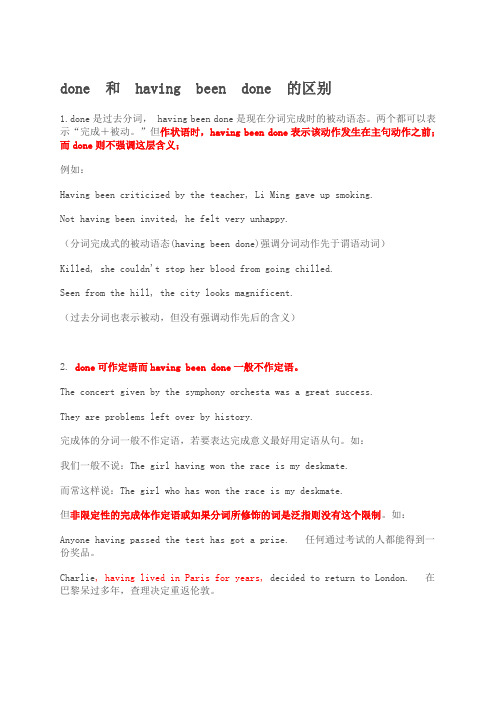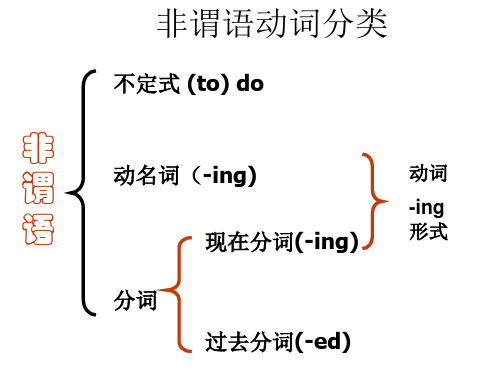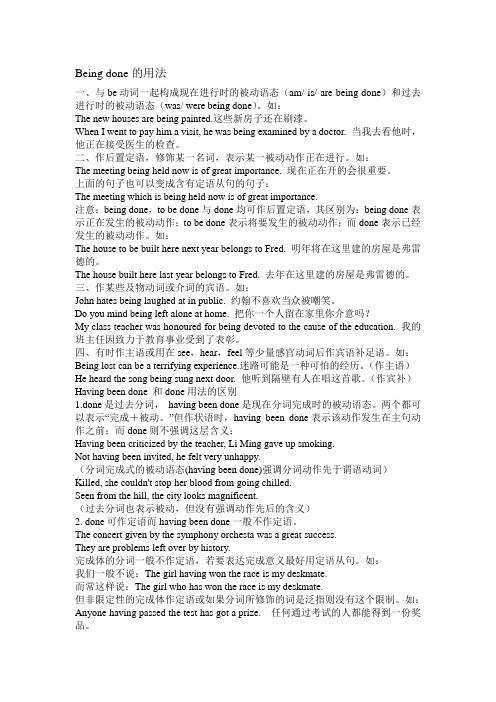(好)done 和 having been done 的区别
- 格式:doc
- 大小:24.00 KB
- 文档页数:2

done 和having been done 的区别1.done是过去分词, having been done是现在分词完成时的被动语态。
两个都可以表示“完成+被动。
”但作状语时,having been done表示该动作发生在主句动作之前;而done则不强调这层含义;例如:Having been criticized by the teacher, Li Ming gave up smoking.Not having been invited, he felt very unhappy.(分词完成式的被动语态(having been done)强调分词动作先于谓语动词)Killed, she couldn't stop her blood from going chilled.Seen from the hill, the city looks magnificent.(过去分词也表示被动,但没有强调动作先后的含义)2. done可作定语而having been done一般不作定语。
The concert given by the symphony orchesta was a great success.They are problems left over by history.完成体的分词一般不作定语,若要表达完成意义最好用定语从句。
如:我们一般不说:The girl having won the race is my deskmate.而常这样说:The girl who has won the race is my deskmate.但非限定性的完成体作定语或如果分词所修饰的词是泛指则没有这个限制。
如:Anyone having passed the test has got a prize. 任何通过考试的人都能得到一份奖品。
Charlie, having lived in Paris for years, decided to return to London. 在巴黎呆过多年,查理决定重返伦敦。


Being done的用法一、与be动词一起构成现在进行时的被动语态(am/ is/ are being done)和过去进行时的被动语态(was/ were being done)。
如:The new houses are being painted.这些新房子还在刷漆。
When I went to pay him a visit, he was being examined by a doctor. 当我去看他时,他正在接受医生的检查。
二、作后置定语,修饰某一名词,表示某一被动动作正在进行。
如:The meeting being held now is of great importance. 现在正在开的会很重要。
上面的句子也可以变成含有定语从句的句子:The meeting which is being held now is of great importance.注意:being done,to be done与done均可作后置定语,其区别为:being done表示正在发生的被动动作;to be done表示将要发生的被动动作;而done表示已经发生的被动动作。
如:The house to be built here next year belongs to Fred. 明年将在这里建的房屋是弗雷德的。
The house built here last year belongs to Fred. 去年在这里建的房屋是弗雷德的。
三、作某些及物动词或介词的宾语。
如:John hates being laughed at in public. 约翰不喜欢当众被嘲笑。
Do you mind being left alone at home. 把你一个人留在家里你介意吗?My class teacher was honoured for being devoted to the cause of the education. 我的班主任因致力于教育事业受到了表彰。

Being done的用法一、与be动词一起构成现在进行时的被动语态(am/ is/ are being done)和过去进行时的被动语态(was/ were being done)。
如:The new houses are being painted.这些新房子还在刷漆。
When I went to pay him a visit, he was being examined by a doctor. 当我去看他时,他正在接受医生的检查。
二、作后置定语,修饰某一名词,表示某一被动动作正在进行。
如:The meeting being held now is of great importance. 现在正在开的会很重要。
上面的句子也可以变成含有定语从句的句子:The meeting which is being held now is of great importance.注意:being done,to be done与done均可作后置定语,其区别为:being done 表示正在发生的被动动作;to be done表示将要发生的被动动作;而done表示已经发生的被动动作。
如:The house to be built here next year belongs to Fred. 明年将在这里建的房屋是弗雷德的。
The house built here last year belongs to Fred. 去年在这里建的房屋是弗雷德的。
三、作某些及物动词或介词的宾语。
如:John hates being laughed at in public. 约翰不喜欢当众被嘲笑。
Do you mind being left alone at home. 把你一个人留在家里你介意吗My class teacher was honoured for being devoted to the cause of the education. 我的班主任因致力于教育事业受到了表彰。

怎么区别动词非谓语动词的时态非谓语动词非谓语动词(不能作谓语用)包括不定式、分词及动名词。
动词不定式1.常用形式:一般主动式to do, 一般被动式to be done完成主动式to have done, 完成被动式to have been done进行式to be doing2.语法功能:可作主语、表语、宾语、宾补、定语和状语(即除谓语之外的各种成分)。
例如:1)主语:To master a foreign language is very important.2)表语:My job is to drive them to the company every day.3)宾语:Do you want to visit the Great Wall?Can you give us some advice on what to do next?宾补:The teacher advised us to have a rest first.I didn´t notice them come in.注:see, hear, watch, notice, have, make, let等动词后作宾补的动词不定式不带to, 但变为被动语态以后(即不定式作主补时)要带to, (其中let sb. do sth. 变为被动式为sb. is let do sth.)help(帮助)后作宾补的动词不定式可带to,也可不带to. 即help sb.(to)do sth. 定语:不定式位于所修饰的名词,代词之后,如:Who was the first one to set to the top of the hill yesterday? /He is the man to depend on/to believe in.6)状语:in order toA.目的状语:She reads China Daily every day so as to improve her English. to注:in order to 可以位于句首或句中,so as to 不能位于句首。

Being done 与done做状语的区别现在分词作状语现在分词作状语时,分词的逻辑主语必须是句子的主语,分词必须和句中的主语含有逻辑上的主谓关系,否则不能用现在分词作状语。
在使用现在分词时,要注意它的各种形式变化:Hearing the bell, the students began to enter the classroom. 听见铃声,学生们开始走进教室。
(听见和进入两个动作同时发生)Being struck by the heavy storm, they felt helpless. 正受到强暴雨的袭击,他们感到很无助。
(strike 与 feel 两个动作同时发生,但 strike 与 they 之间逻辑关系是被动的 )Having done the work, he went home. 完成了工作,他就回家了。
Having been told many times, he still repeated the same mistake . 给他讲过好几回,他还是犯同样的错。
分词在句中作状语,修饰谓语动词或整个句子,表示动作发生的原因、时间、方式、结果、条件、伴随状况等。
与其它非谓语动词作状语用法区别简析:1. 分词在句中不作目的状语(表目的状语用不定式)。
不定式作状语只在句中表目的、结果、原因、程度。
2. 现在分词的一般式,表示该动作与主句谓语动词同时或基本同时发生;现在分词的完成式,表示该动作先于主句谓语动作发生。
过去分词表被动完成3. 现在分词的一般式的被动式(即 being done) 一般只作原因状语置句首;现在分词的完成式(即 having done; having been done) 在句中作时间原因状语。
Walking in the street, I came across an old friend of mine.表示时间关系的分词短语,可用 when 或 while 引出。
“Having done / Having been done”用法讲练Jan 11, 2013初稿May 9, 2020整理规则:这两种分词动作,发生在主句谓语动作之前。
强调分词动作“先完成”,然后才发生主句谓语的动作。
这两种分词形式,多做状语或非限制性定语。
Having done为主动;Having been done为被动。
这两种分词形式后,常跟次数或一段时间。
例如:1.Having finished his homework, the boy felt happy.写完了作业,男孩感觉很开心。
(Having finished...,做状语。
)2.The boy, having finished his homework, felt happy.写完了作业的男孩,感觉很开心。
(having finished...,做后置定语。
)3.Having been told many times, he finally understood it.被告诉了很多次,他终于明白了。
(Having been told...,做状语。
)Having done专练:1. ____ such heavy loss in the hurricane, the farmer didn’t expect to have a good harvest.A. SufferingB. Having sufferedC. SufferedD. To suffer(答案B.解析:Having suffered...,放句首做状语。
句意:农民先遭受损失,后产生心理预期。
)2. The manager, ____ it clear to us that he didn’t agree with us, left the meeting room.(2005江西)A.who has madeB. having madeC. madeD. making(答案B.解析:having made...,做后置定语。
怎么区别动词非谓语动词的时态非谓语动词非谓语动词(不能作谓语用)包括不定式、分词及动名词。
动词不定式1.常用形式:一般主动式to do, 一般被动式to be done完成主动式to have done, 完成被动式to have been done进行式to be doing2.语法功能:可作主语、表语、宾语、宾补、定语和状语(即除谓语之外的各种成分)。
例如:1)主语:To master a foreign language is very important.2)表语:My job is to drive them to the company every day.3)宾语:Do you want to visit the Great Wall?Can you give us some advice on what to do next?宾补:The teacher advised us to have a rest first.I didn´t notice them come in.注:see, hear, watch, notice, have, make, let等动词后作宾补的动词不定式不带to, 但变为被动语态以后(即不定式作主补时)要带to, (其中let sb. do sth. 变为被动式为sb. is let do sth.)help(帮助)后作宾补的动词不定式可带to,也可不带to. 即help sb.(to)do sth. 定语:不定式位于所修饰的名词,代词之后,如:Who was the first one to set to the top of the hill yesterday? /He is the man to depend on/to believe in.6)状语:in order toA.目的状语:She reads China Daily every day so as to improve her English. to注:in order to 可以位于句首或句中,so as to 不能位于句首。
分词与独立主格结构分词的结构现在分词:doing/being done/having done/having been done过去分词:done分词用途定语单个的分词为定语通常是前置,特别是现在分词,其中现在分词表示主动且正在进行的含义,过去分词表示被动(及物动词)或已经完成的含义(不及物动词);对声音和表情的修饰常用过去分词;某些单个过去分词前置与后置有区别:the given time/the time giventhe wanted person/the person wanteda concerned look/the persons concernedan involved sentence/the persons involved2) 分词短语为定语需要后置,相当于一个定语从句,用doing表示主动且正在进行的含义;用being done 表示被动且正在进行的含义;用done表示被动且已经完成的含义;用to be done 表示将来被动的含义,没有having done和having been doneThe bridge ______(build)next year will join up the two islands.The bridge ______(build)in 1960 is the first modern one in Chongqing.The bridge ______(build)will be completed next week.思考:是否所有的定语从句都可以改为分词结构吗?下列两个句子可以改为分词结构吗?The man who came this morning is his father.Is there anyone who can drive a car?表语现在分词作为表语表示主语所具有的特征,过去分词为表语表示主语所处的状态1). The animal and plants that they found there were (astonish)2). I was (astonish) to learn that his long lost child had been found.3). The news made us .(diappoint)4). The mother went to visit Einstein. (puzzle)5). Madame Curie found husband’s death .(shock)6). I saw the boy very (excite)7). Be brave. You look like a bird (frighten)8). The fierce lion looks (frighten). Keep away from its cage or it will attack you.9). The food served at the dinner party did not seem very (invite)3.宾语补足语现在分词在see, watch, hear, observe, notice, feel, find, glimpse, glance 等感官动词和look at, listen to 等短语动词,以及have, keep, get, catch, leave, set, start, send等使役动词后面与名词或代词构成复合宾语,作宾语补语的成分。
having been done的用法"having been done"是英语中的一个过去分词结构,它是由"have/has/had been"和动词的过去分词构成的,用于描述过去已经完成的动作或状态。
它在句子中通常用作主语、宾语、表语或状语。
例如:- Having been done correctly, the project was finished on time. (项目正确地完成了,因此按时完成了。
)- Having been promoted to manager, he now has more responsibilities. (由于已经被提升为经理,他现在有更多的责任。
)除了作为句子成分之外,"having been done"还可用于构成时间状语从句,表示在某个过去的时间点已经发生过的动作或状态,如:- Having been married for ten years, they decided to start a family. (他们已经结婚十年了,决定要开始组建一个家庭。
)- Having been working for the company for five years, she was ready for a promotion. (她已经为这家公司工作了五年,准备升职。
)需要注意的是,"having been done"这一结构的使用需要考虑上下文语境和时态,需要与句子中其他动词的时态和语态保持一致。
"having been done"使用灵活,可用于不同语境下的句子。
以下是一些常见的用法:1. 作为主语"having been done"可用作主语,用于描述一个已经完成的动作或一种状态。
例如:- Having been caught in a traffic jam, he was late for the meeting. (由于遇到了交通拥堵,他迟到了会议。
done 和having been done 的区别
1.done是过去分词, having been done是现在分词完成时的被动语态。
两个都可以表示“完成+被动。
”但作状语时,having been done表示该动作发生在主句动作之前;而done则不强调这层含义;
例如:
Having been criticized by the teacher, Li Ming gave up smoking.
Not having been invited, he felt very unhappy.
(分词完成式的被动语态(having been done)强调分词动作先于谓语动词)
Killed, she couldn't stop her blood from going chilled.
Seen from the hill, the city looks magnificent.
(过去分词也表示被动,但没有强调动作先后的含义)
2. done可作定语而having been done一般不作定语。
The concert given by the symphony orchesta was a great success.
They are problems left over by history.
完成体的分词一般不作定语,若要表达完成意义最好用定语从句。
如:
我们一般不说:The girl having won the race is my deskmate.
而常这样说:The girl who has won the race is my deskmate.
但非限定性的完成体作定语或如果分词所修饰的词是泛指则没有这个限制。
如:
Anyone having passed the test has got a prize. 任何通过考试的人都能得到一份奖品。
Charlie, having lived in Paris for years, decided to return to London. 在巴黎呆过多年,查理决定重返伦敦。
The man, having been disturbed so badly, almost lost his memory. 由于被严重困扰,这个人几乎失去了记忆。
(The man, who had been disturbed so badly, almost lost his memory.)
3. 如果分词是短暂动词,那么该分词完成式所表示的动作往往是在谓语动作之前发生过多次,请看例句:
(1)Having been bitten twice, the postman refused to deliver our letters unless we chained our dog up.
妙语点睛:
分词完成式having been bitten在谓语动作refused之前已经重复过两次,即分词完成式用于短暂动作时往往会体现出重复性的特点。
【译文】
邮递员被狗咬了两次之后要我们把狗拴起来,不然就不给我们送信了。
这一点在现在分词主动完成式中也一样,如:
(2)Having failed three times, he didn't want to try again.
妙语点睛:
分词完成式having failed在谓语动作want之前已经重复过三次,即分词完成式用于短暂动作时往往会体现出重复性的特点。
【译文】
已经失败了三次,他不想再试了。